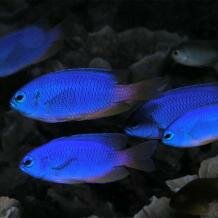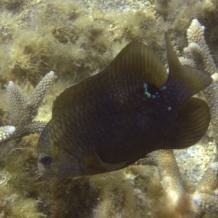Topic: Agriculture in damselfish
Don’t be tempted to think human agriculture is unique. On many coral rocks, there are very similar things going on…
Fish show a wide diversity of feeding types, amongst which grazing and nibbling are especially common.  This is a necessary prerequisite for a rather remarkable agriculture that has evolved amongst the damselfish, which are typical inhabitants of tropical coral reefs but occur in other habitats as well. Here algae are prolific, but these fish do in fact maintain farms of algae that are harvested for food, with management techniques similar to those of other animal gardeners, such as attine ants, termites or limpets, and even humans.
This is a necessary prerequisite for a rather remarkable agriculture that has evolved amongst the damselfish, which are typical inhabitants of tropical coral reefs but occur in other habitats as well. Here algae are prolific, but these fish do in fact maintain farms of algae that are harvested for food, with management techniques similar to those of other animal gardeners, such as attine ants, termites or limpets, and even humans.
Damselfish farming activity can have profound effects on the structure of the algal community. The territorial fish protect their dense stands of filamentous algae aggressively from other herbivores, thus reducing grazing pressure and increasing productivity. Non-destructive cropping of algae, which promotes exponential growth, is often observed, and some damselfish even selectively weed out indigestible algal species. Whilst the majority of farming fish grow several different algae, in certain cases it is evidently a monoculture (e.g. in Microspathodon dorsalis and Stegastes nigricans).
Dusky farmerfish (Stegastes nigricans)
In a Japanese lagoon, this damselfish species manages algal farms that are dominated by the early-colonising filamentous rhodophyte Womersleyella setacea that is hardly found outside the fish’s territories. The farmerfish intensively and selectively weeds out late-colonising algae that are competitively superior to W. setacea but indigestible, such as calcareous Jania algae and thick rhodophytes.  As fish lack the enzymes and morphological specialisations needed to digest plant cell walls, the range of edible algae is limited, and weeding allows the fish to effectively harvest nutritious, digestible algae. In addition to weeding, W. setacea traps sediment, which reduces the hard substratum available for colonisation by other algae.
As fish lack the enzymes and morphological specialisations needed to digest plant cell walls, the range of edible algae is limited, and weeding allows the fish to effectively harvest nutritious, digestible algae. In addition to weeding, W. setacea traps sediment, which reduces the hard substratum available for colonisation by other algae.
Elsewhere on the Japanese coast, S. nigricans was shown to cultivate a different species of filamentous red alga (Polysiphonia sp.). The algal farms are aggressively defended against invading herbivores, and unpalatable competitive algae are also removed regularly. In absence of such weeding, Polysiphonia is rapidly overgrown by other species of alga. As the alga does not occur outside the farms of Stegastes, this is an example of an obligate cultivation mutualism (as found in attine ants, termites and ambrosia beetles and, of course, humans). The algal farms are usually transmitted from one generation to the next, and upon colonisation of a new habitat the fish may use water-borne fragments or spores of the alga.
There are also facultative associations between other species of Polysiphonia algae and damselfish, where the alga does not exclusively depend on the fish or the fish maintains mixed-culture farms without weeding. Those Polysiphonia species that are specialised to particular damselfish species are probably not monophyletic, “suggesting that the adaptations of these algae to damselfishes originated independently” (Hata & Kato 2006, Biology Letters, vol. 2, p. 595).
Brazilian damsel (Stegastes fuscus)
This species strongly influences the benthic community structure on rocky shores by maintaining the algal community in its territories in an early succession stage, where fast-growing species prevail. Thus, algal biomass and density are higher inside fish territories, and the dominance of Jania algae that is often observed outside territories is prevented. In contrast to the dusky farmerfish, the Brazilian damsel is not specialised on a particular algal species but cultivates and feeds on a variety of filamentous and calcareous algae. The fish’s faeces do not seem to enhance algal productivity, as observed for example in gardening pear limpets that fertilise their algal gardens with nitrogenous excretions.
Cite this web page
Map of Life - "Agriculture in damselfish"
https://mapoflife.org/topics/topic_466_agriculture-in-damselfish/
November 29, 2020

